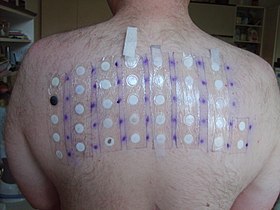Patch test
| Patch test | |
|---|---|
| Intervention | |

Patch test
|
|
| MeSH | D010328 |
A patch test is a method used to determine whether a specific substance causes allergic inflammation of a patient's skin. Any individual suspected of having allergic contact dermatitis or atopic dermatitis needs patch testing.
Patch testing helps identify which substances may be causing a delayed-type allergic reaction in a patient, and may identify allergens not identified by blood testing or skin prick testing. It is intended to produce a local allergic reaction on a small area of the patient's back, where the diluted chemicals were planted. The chemicals included in the patch test kit are the offenders in approximately 85–90 percent of contact allergic eczema, and include chemicals present in metals (e.g., nickel), rubber, leather, formaldehyde, lanolin, fragrance, toiletries, hair dyes, medicine, pharmaceutical items, food, drink, preservative, and other additives.
A patch test relies on the principle of a type IV hypersensitivity reaction.
The first step in becoming allergic is sensitization. When skin is exposed to an allergen, the antigen presenting cells (APCs) – also known as Langerhans cell or Dermal Dendritic Cell – eat up the substance (phagocytoze) and break it into smaller pieces. This is where a substance is recognized by immune cells in the skin. They then put parts of the substance onto their surface (technically, they hold the part of the molecule on the surface in the type two (MHC-II)). Once this is done, the APC moves down the lymphatic system to a lymph node, where it presents this part of the substance (what we now call an antigen) to a particular immune cell called a CD4+ T-cell, or T-helper cell. The T-cell, if it recognizes the substance as dangerous, expands in number and sends out more of itself to the skin, at the site of antigen exposure.
When the skin is again exposed to the antigen, the memory t-cells in the skin recognize the antigen and produce cytokines (chemical signals), which cause more T-cells to migrate from blood vessels. This starts a complex immune cascade leading to skin inflammation, itching, and the typical rash of contact dermatitis.
...
Wikipedia
